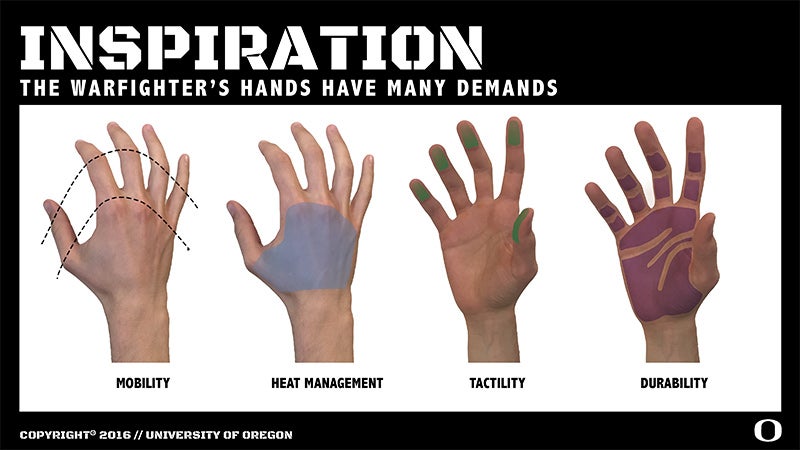A team from the University of Oregon Department of Product Design has taken on the challenge of protecting military service members during chemical or biological attacks.
Susan Sokolowski, associate professor and director of the Sports Product Design Program, and undergraduate student Juliann Larese have made it to the final round of a Department of Defense competition to design clothing better suited for “warfighters”—soldiers, sailors, marines, and airmen. Winners will be announced in January.
The design competition, called “Proof: The Chembio Suit Design Challenge”, seeks ideas for better protection, and is offering awards totaling $250,000 for the most innovative solutions.
“The ultimate goal is to relieve any burdens and hazards to the warfighter and improve operational capabilities in combating chemical and biological wartime threats,” the challenge website states.
Sokolowski and Larese opted to redesign gloves.

Above: This image outlines the needs of the soldiers, sailors, marines, and airmen and the challenges that Susan Sokolowski, director of the Sports Product Design Program, and undergraduate Juliann Larese intend to solve with their design solution. Image courtesy Susan Sokolowski.
“We created a solution that involved a three-part innovation approach that, when compiled together, would create a lighter, more mobile glove with better heat management, tactility, and dexterity for the warfighter,” Sokolowski and Larese’s project states.
The current two-layered gloves can get too hot and limit dexterity.
The UO team’s design uses nylon, cotton, activated carbon, and conductive fibers specially knitted to result in a lighter, one-layer glove that better enables use with touchscreen devices. The glove is proposed to be manufactured through a “3D flat knitting process” to optimize the combination of materials.
“The innovation has to start at the fiber/yarn level,” their project states. “Carbon can be a great solution for the glove, as it can move moisture off the skin into the material system for evaporation, traps odor, and provides UV protection.”
Sokolowski, principal investigator for the proposal, has written more than 35 patents for athletic shoes, gloves, and other gear. Prior to joining the UO, she worked for Nike for 17 years in materials and product design.
Larese plans to graduate in June and hopes to work as a designer in the sports product design industry in Portland.
The competition is offered by the Joint Program Executive Office for Chemical and Biological Defense (JPEO-CBD), a division within the US Department of Defense.
